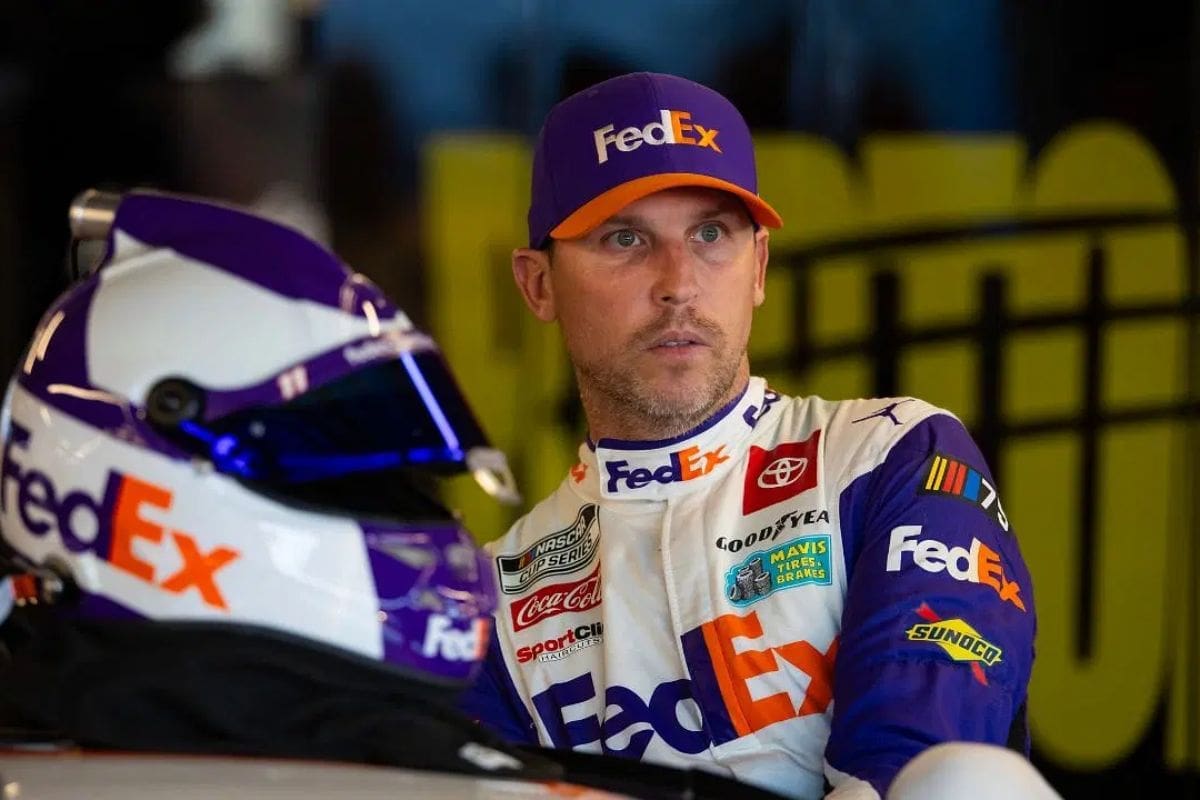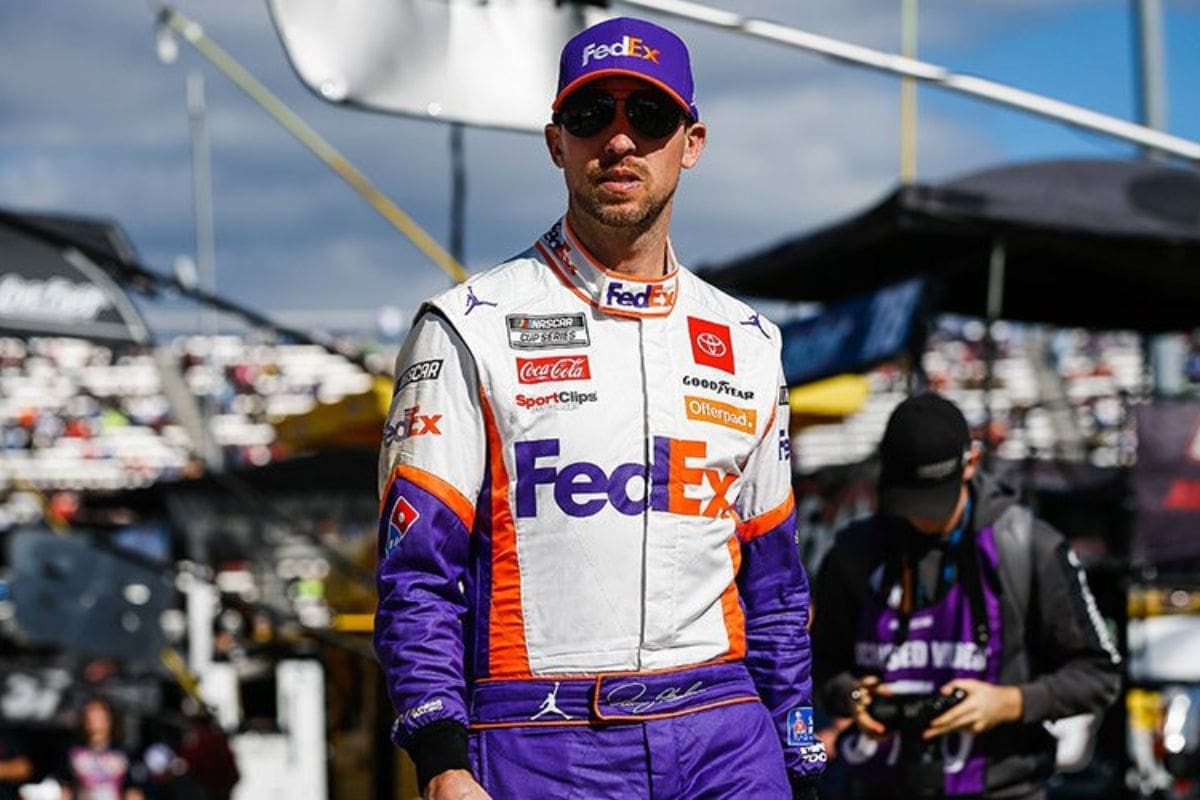NASCAR Strips Denny Hamlin’s Advantage: NASCAR’s recent partnership with Goodyear to introduce dual-compound tires is poised to redefine competitive dynamics within the sport, particularly impacting top-tier drivers like Denny Hamlin. Known for his race strategies, Hamlin now faces a challenge of adjusting to the unpredictability these new tire variables bring. This inventive shift aims to boost race excitement as a whole and necessitates rapid adaptability among all teams. As we approach the Richmond event, the motorsport community is abuzz with speculation on how these changes will unfold, promising an interesting evolution in race strategy and competition.
Key Highlights
- Goodyear’s new dual tire compounds aim to level the playing field by challenging teams with unpredictable tire performance.
- Denny Hamlin must adapt his strategy to handle the complexities introduced by the new tire compounds.
- Real-time data analysis and quick adaptability are essential for teams to manage tire performance effectively during races.
- The new tire compounds could nullify previous strategic advantages, enhancing race competitiveness and excitement.
- Tire management becomes crucial as teams navigate the challenges posed by different track surfaces and tire degradation rates.
Tire Handling Controversy
The 2023 NASCAR season has been filled with a variety of controversies, yet none have captured the community quite like the unexpected focus on tire handling during the spring race at Bristol. This event, often overshadowed by other more flashy aspects of racing, drew intense scrutiny from drivers, teams, and fans alike, thrusting tire performance into the spotlight.
Historically, tire handling has always been a crucial but overlooked component of NASCAR strategy. However, the Bristol race made it the focal point of discussion due to the unique challenges posed by the track’s abrasive surface and the high-speed demands of the race. This attention revealed a noticeable difference between those who excelled in the art of tire preservation and those who struggled, leading to notable shifts in race outcomes and championship standings.
Denny Hamlin, a seasoned driver known for his strategic skills, found himself at the center of this tire-focused narrative. His apparent advantage in tire handling became a focal point, raising eyebrows and fueling debates about fairness and competitive balance. Critics argued that certain drivers had an unfair edge due to their ability to better manage tire wear, while others saw it as a display of skill and experience.
The Bristol race served as a representative of larger issues affecting the sport, such as equipment equality and rule enforcement. It highlighted the need for NASCAR to address these concerns directly, ensuring a more fair playing field. The tire handling controversy not only brought out the subtleties of race strategy but also sparked a broader conversation about the fair distribution of competitive resources in NASCAR.
NASCAR’s New Tire Strategy
In response to the heightened scrutiny on tire handling and calls for a more level playing field, NASCAR has introduced a new tire approach aimed at further refining competitive balance. This approach, making its debut at the Richmond race next month, involves the use of dual tire compounds in a regular-season points-paying event. This bold move comes on the heels of NASCAR’s experimental approach at the All-Star Race, where multiple tire compounds were initially tested to varying degrees of success.
The introduction of dual tire compounds is poised to add a new layer of strategy and unpredictability to the race. Drivers and teams will have to make critical decisions regarding tire selection, balancing the potential performance benefits against the durability and wear characteristics of each compound. This innovation is expected to shake up race dynamics significantly, as it introduces a variable that could potentially alter the competitive landscape.
Goodyear, NASCAR’s exclusive tire supplier, has been instrumental in developing these compounds to ensure they meet the rigorous demands of high-speed racing while also offering distinct performance attributes. The aim is to create a scenario where tire management becomes a crucial aspect of race strategy, thus rewarding teams that can adeptly navigate these new challenges.
However, this new approach is not without its potential drawbacks. There are concerns about how well teams will adapt to the dual tire compounds and whether it will lead to unforeseen complications during the race. Nevertheless, NASCAR’s commitment to innovation and enhancing the sport’s competitive spirit remains steadfast, as evidenced by this latest initiative.
Denny Hamlin’s Reaction and Strategy
Facing NASCAR’s new tire plan for the Richmond race, Denny Hamlin and his crew chief Chris Gabehart are carefully adjusting their approach to keep a competitive advantage. The introduction of optional tires alongside the primary Goodyear compound adds an unprecedented layer of complexity to the upcoming Federated Auto Parts 400.
Known for their skill at handling unpredictable scenarios, Hamlin and Gabehart tackle the challenge directly, leveraging their well-honed tactical expertise. Hamlin’s initial response to the update was one of cautious optimism. While recognizing that the new tire plan could undermine his team’s established approach, he remains confident in their ability to adapt.
Gabehart, similarly, has been methodically analyzing data and simulations to craft a game plan that incorporates the variable tire options effectively. Key elements of Hamlin and Gabehart’s strategy include:
- Data-Driven Decisions: Gabehart is using a data-centric approach, utilizing past performance metrics and simulations to predict the optimal moments for tire changes.
- Real-Time Adaptability: The team is preparing to make quick, in-race adjustments based on tire wear and track conditions, ensuring they can adjust their strategy as necessary.
- Driver-Crew Harmony: Hamlin and Gabehart’s communication will be essential, with Gabehart providing detailed feedback and Hamlin offering on-the-ground insights to fine-tune their strategy dynamically.
Concerns and Expectations
Although Denny Hamlin and Chris Gabehart are renowned for their adaptability, concerns about the impact of NASCAR’s new tire plan on their carefully crafted strategy are noticeable. Hamlin openly expressed his reservations, noting that while the 11 car team prefers a straightforward race to test their mettle, the introduction of a new tire compound could disrupt their established approach. This feeling highlights the intricate balance teams must strike between strategy and adaptability in a sport where small changes can produce noteworthy ripple effects.
“Personally, on the 11 car, do we love throwing in these kinks, no, we’d rather race straight up and see how it plays out.” But then he admitted to his eagerness for the short-track effort on NASCAR’s part. “At the same time, I understand why we’re doing it and applaud Goodyear for trying it just to see if we can come up with a better primary tire long-term for short tracks. A lot of this will depend on what this tire does — is it fast for three laps or 10 or 15?” – Hamlin
Hamlin’s recognition of Goodyear’s initiative to innovate for short tracks reveals a duality in his perspective. While he appreciates the potential long-term benefits of finding a superior primary tire, the immediate implications on race performance remain uncertain. The key variable, as Hamlin highlighted, is the tire’s durability and performance span. Whether the tire remains fast for three laps or extends its competitive edge to 10 or 15 laps could significantly alter race strategies, particularly regarding pit stop timing and tire management.
This development has sparked a mix of anticipation and concern within the NASCAR community. Teams are keen to understand how the new tire will perform under race conditions, and whether it will level the playing field or favor particular driving styles and setups. The uncertainty demands heightened vigilance and swift adaptability from all teams, not just Hamlin’s.
Challenges Ahead
Handling the intricacies introduced by the new tire compound, Denny Hamlin and his team must recalibrate their strategies to address the unpredictable performance variables that now loom over each race. The Food City Dirt Race in March set the stage for these challenges, as Bristol Motor Speedway’s abrasive surface led to a record-breaking 54 lead changes. This unexpected scenario forced drivers, with the notable exception of Hamlin, to adapt their tactics on the fly or risk descending into disarray.
The upcoming races will undeniably test the resilience and ingenuity of Hamlin’s crew. The new tire compound, designed by Goodyear, introduces several layers of unpredictability, compelling teams to think on their feet and make real-time adjustments. The ability to predict tire degradation and manage pit stops will become a critical factor in maintaining a competitive edge.
“I mean, from the minute practice was over, we suspected something was going to be different. I think a lot of us thought maybe 80 (laps), 100 in, this place would rubber in and get a little more familiar. But it did not. It was a blast. I’m not just saying that because we won. I’m saying that because it was fun to have to do something so unrefined.” – Hamlin
- Tire Management: Teams must develop a deeper understanding of how the new compound interacts with different track surfaces to optimize tire longevity and performance.
- Strategic Adaptability: Real-time data analysis and quick decision-making will be crucial to respond to the evolving conditions during the race.
- Driver Skill: The ability of the driver to adapt to the changing grip and handling characteristics of the tires will play a crucial role in maneuvering the complexities of each race.
Hamlin’s previous edge has been nullified, leveling the playing field and intensifying the competition. The challenge now lies in how well teams can master the use of the new tire compound. As the season progresses, the strategies developed in response to these changes will define not only individual race outcomes but potentially the overall championship standings.
News in Brief: NASCAR Strips Denny Hamlin’s Advantage
The introduction of Goodyear’s dual compound tires represents a game-changing shift in NASCAR’s competitive landscape, mandating quick adjustment from teams and drivers.
This tactical overhaul promises to disrupt established advantages, specifically those held by Denny Hamlin, and infuses a new level of unpredictability into races.
As the sport braces for heightened competitiveness and dynamic strategies, the Richmond event will serve as a critical test of resilience and ingenuity in maneuvering these unprecedented changes.
ALSO READ: Denny Hamlin’s Pocono Race Warning: Absence of the Main Weather-Proof Strategy




